Property from an Italian Collector Agostino Bonalumi Follow Untitled enamel on shaped canvas, in 4 parts part 1 150 x 150 x 4.5 cm (59 x 59 x 1 3/4 in.) part 2 170.5 x 150.5 x 9 cm (67 1/8 x 59 1/4 x 3 1/2 in.) part 3 215.5 x 104.5 x 28.5 cm (84 7/8 x 41 1/8 x 11 1/4 in.) part 4 280 x 76 x 34 cm (110 1/4 x 29 7/8 x 13 3/8 in.) Executed in 1973, this work is accompanied by a certificate of authenticity from the Archivio Agostino Bonalumi Milan and is recorded under no. 73-047.
Provenance Private Collection, Italy (gifted by the artist) Thence by descent to the present owner Catalogue Essay Stretching almost five-metres wide, Agostino Bonalumi’s Untitled , 1973, is composed of four identically sized white canvases which, in sequence, seem to unroll an abstract narrative. Inhabited by geometrically formed protrusions, the assembled paintings expand across two walls as though in motion. As a result, the installation is as conceptually innovative as it is spatially impressive, effectively aligning with the Italian artist’s fundamental motivation to materialise new ways of interacting with space. The work’s date of execution is also not inconsequential: it immediately precedes a retrospective of the artist’s at Palazzo dei Musei, Modena, in 1974, and is inscribed in a period of extensive spatial experimentation, amounting to the creation of some of Bonalumi’s most striking works. Untitled ’s rhythmic protrusions, or ‘extroflections’ (estroflessioni) as Bonalumi names them, stimulate the gaze progressively from one end of the installation to the other, occasionally pointing outwards towards the architecture of the room. In doing so, they invite the viewer to move in space, transforming the act of observation into a spatial experience. The extroflections at the left end of the installation shoot towards their closest margin like arrows, whilst they themselves diverge away from each other, forming two separate groups of straight lines in a mirrored structure. Here, Bonalumi utilises a sense of physical projection to establish a dialogue between the painting-object and the physical space enveloping it, creating for the witnessing viewer a dynamic sensory experience. ‘My work is one of the first expressions of this current trend that considers space as the construction and objectification of the work…Its spatiality- its physicality - is always a projection of the physicality of the space of our experience’ (Agostino Bonalumi Francesca Pola, eds., Agostino Bonalumi All the Shapes of Space 1958 - 1976 , Milan, 2013, p. 114), he declared. As the vinyl stretches over the protrusions like a layer of skin, Untitled ’s fabric furthermore extends outwards and transcends its initial two-dimensional disposition. Its shiny surface enhances the impression that a force is emanating from the work, and thus visually accentuates the tension of the overall composition. When creating extroflections, Bonalumi placed particular importance on the research of adequate materials, utilising the latter to achieve previously imagined designs with precision: ‘The material that stretches the canvas is designed and developed to stretch it at a certain tension. Frames and canvases are designed according to measurement that condition and calibrate one another’ (Agostino Bonalumi quoted in Francesca Pola, ‘Beauty has to be experienced, not described: A conversation with Agostino Bonalumi’, Agostino Bonalumi All the Shapes of Space 1958 – 1976 , Milan, 2013, p. 190). The texture and elasticity of the chosen materials were thus key in shaping Bonalumi’s creative vision; in this perspective, the artist exclaimed: ‘My work has never been about indulging a material for the sake of it. It’s the result of an active interest in materials themselves, the intelligence of materials. I looked for materials that could breathe life into ideas: the idea had to be associated with a material that worked and was able to bring it to life, through a real experience’ (Agostino Bonalumi quoted in Francesca Pola, ‘Beauty has to be experienced, not described: A conversation with Agostino Bonalumi’, Agostino Bonalumi All the Shapes of Space 1958 – 1976 , Milan, 2013, p. 9). Eluding the flatness traditionally defining the medium of painting, Bonalumi brings forth a new form of representation working upon light, space, and form simultaneously. By materialising energetic structures drawing from such strong compositional sources, the Italian artist reconsiders th
Property from an Italian Collector Agostino Bonalumi Follow Untitled enamel on shaped canvas, in 4 parts part 1 150 x 150 x 4.5 cm (59 x 59 x 1 3/4 in.) part 2 170.5 x 150.5 x 9 cm (67 1/8 x 59 1/4 x 3 1/2 in.) part 3 215.5 x 104.5 x 28.5 cm (84 7/8 x 41 1/8 x 11 1/4 in.) part 4 280 x 76 x 34 cm (110 1/4 x 29 7/8 x 13 3/8 in.) Executed in 1973, this work is accompanied by a certificate of authenticity from the Archivio Agostino Bonalumi Milan and is recorded under no. 73-047.
Provenance Private Collection, Italy (gifted by the artist) Thence by descent to the present owner Catalogue Essay Stretching almost five-metres wide, Agostino Bonalumi’s Untitled , 1973, is composed of four identically sized white canvases which, in sequence, seem to unroll an abstract narrative. Inhabited by geometrically formed protrusions, the assembled paintings expand across two walls as though in motion. As a result, the installation is as conceptually innovative as it is spatially impressive, effectively aligning with the Italian artist’s fundamental motivation to materialise new ways of interacting with space. The work’s date of execution is also not inconsequential: it immediately precedes a retrospective of the artist’s at Palazzo dei Musei, Modena, in 1974, and is inscribed in a period of extensive spatial experimentation, amounting to the creation of some of Bonalumi’s most striking works. Untitled ’s rhythmic protrusions, or ‘extroflections’ (estroflessioni) as Bonalumi names them, stimulate the gaze progressively from one end of the installation to the other, occasionally pointing outwards towards the architecture of the room. In doing so, they invite the viewer to move in space, transforming the act of observation into a spatial experience. The extroflections at the left end of the installation shoot towards their closest margin like arrows, whilst they themselves diverge away from each other, forming two separate groups of straight lines in a mirrored structure. Here, Bonalumi utilises a sense of physical projection to establish a dialogue between the painting-object and the physical space enveloping it, creating for the witnessing viewer a dynamic sensory experience. ‘My work is one of the first expressions of this current trend that considers space as the construction and objectification of the work…Its spatiality- its physicality - is always a projection of the physicality of the space of our experience’ (Agostino Bonalumi Francesca Pola, eds., Agostino Bonalumi All the Shapes of Space 1958 - 1976 , Milan, 2013, p. 114), he declared. As the vinyl stretches over the protrusions like a layer of skin, Untitled ’s fabric furthermore extends outwards and transcends its initial two-dimensional disposition. Its shiny surface enhances the impression that a force is emanating from the work, and thus visually accentuates the tension of the overall composition. When creating extroflections, Bonalumi placed particular importance on the research of adequate materials, utilising the latter to achieve previously imagined designs with precision: ‘The material that stretches the canvas is designed and developed to stretch it at a certain tension. Frames and canvases are designed according to measurement that condition and calibrate one another’ (Agostino Bonalumi quoted in Francesca Pola, ‘Beauty has to be experienced, not described: A conversation with Agostino Bonalumi’, Agostino Bonalumi All the Shapes of Space 1958 – 1976 , Milan, 2013, p. 190). The texture and elasticity of the chosen materials were thus key in shaping Bonalumi’s creative vision; in this perspective, the artist exclaimed: ‘My work has never been about indulging a material for the sake of it. It’s the result of an active interest in materials themselves, the intelligence of materials. I looked for materials that could breathe life into ideas: the idea had to be associated with a material that worked and was able to bring it to life, through a real experience’ (Agostino Bonalumi quoted in Francesca Pola, ‘Beauty has to be experienced, not described: A conversation with Agostino Bonalumi’, Agostino Bonalumi All the Shapes of Space 1958 – 1976 , Milan, 2013, p. 9). Eluding the flatness traditionally defining the medium of painting, Bonalumi brings forth a new form of representation working upon light, space, and form simultaneously. By materialising energetic structures drawing from such strong compositional sources, the Italian artist reconsiders th



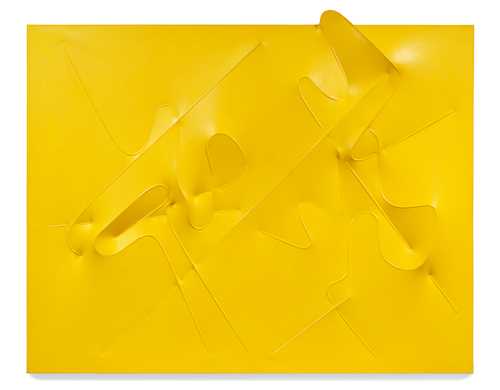
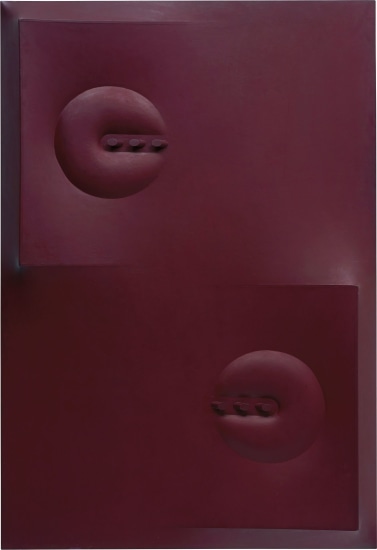


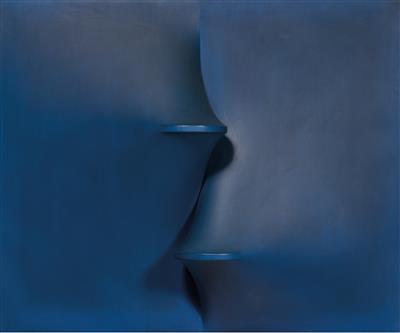

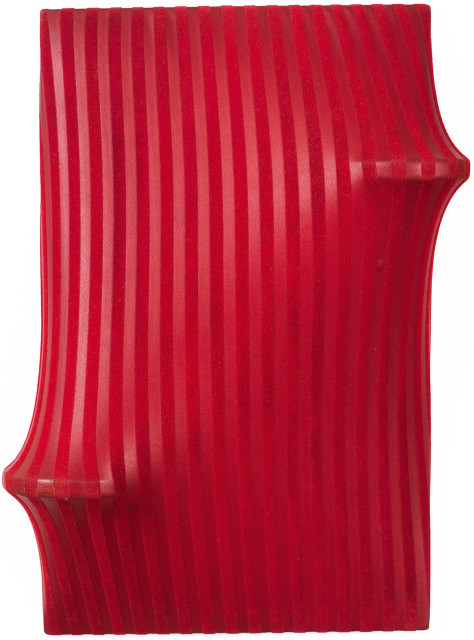


.jpg)
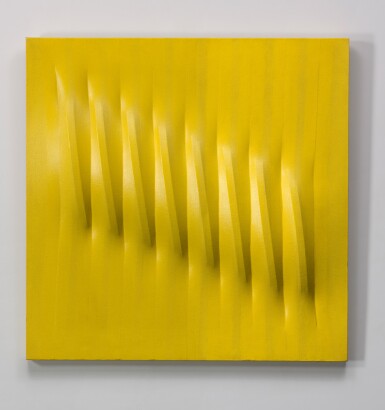

Try LotSearch and its premium features for 7 days - without any costs!
Be notified automatically about new items in upcoming auctions.
Create an alert